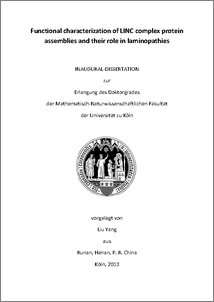Yang, Liu
(2013).
Functional characterization of LINC complex protein assemblies and their role in laminopathies.
PhD thesis, Universität zu Köln.

![[img]](https://kups.ub.uni-koeln.de/style/images/fileicons/application_pdf.png)  Preview |
|
PDF
Thesis--Liu_Yang--Functional_characterization_of_LINC_complex_protein_assemblies_and_their_role_in_laminopathies.pdf
Download (4MB)
|
Abstract
LINC (Linker of nucleoskeleton and cytoskeleton) complexes connect the nucleoskeleton to the cytoskeleton by interactions among LINC complex proteins and their interactions to proteins in the nucleus and the cytosol. Nesprins (nuclear envelope spectrin repeat proteins) are core components of the LINC complex, together with their interaction partners along the nuclear envelope, such as lamins that form meshwork along inner nuclear membrane, they play critical roles in regulating many cellular functions including the maintenance of the structural integrity of nucleus and cytoskeleton or proper signal transduction across the NE. Mutations in LINC complex or associated proteins, especially in lamin A/C, result in a variety of human diseases such as muscular dystrophies, neuropathies, lipodystrophy and progeria, that are collectively known as laminopathies.
Here we narrowed down the binding site between nesprin-2 and lamin A to aa 403-425 in lamin A and aa 6146-6347 in nesprin-2. Additionally, laminopathy causing mutations in or near the binding sites of both proteins were analyzed in this study. Currently only mutations in LMNA encoding lamin A/C have been described along the interaction sites. The lamin A mutations R401C (1201 C>T), G411D (1232G>A), G413C (1237G>T), V415I (1243G>A), R419C (1255T>C), L421P (1261T>C), R427G (1279C>G) and Q432X (1294C>T) were analyzed in this study. All lamin A mutations analyzed here lie in a loop between the central alpha helical rod and the C-terminal globular tail and are thus accessible for interaction. They modulate the interaction with nesprin-2 in a range from increasing to decreasing. The wide range of variations reflects the wide range of diseases caused by the mutations analyzed here, indicating that altered biochemical properties among distinct LINC complex components contribute to the formation of distinct laminopathies with different phenotypes. The most notable mutation was the lamin A mutation Q432X that formed aggregates along the NE and altered LINC complex protein assemblies by the sequestration of nesprin-2, lamin B1, emerin or lamin A/C. Additionally Q432X aggregates altered chromatin structure and transcription factor arrangements.
| Item Type: |
Thesis
(PhD thesis)
|
| Translated abstract: |
| Abstract | Language |
|---|
| LINC (Linker of nucleoskeleton and cytoskeleton)Komplexe verbinden das Zellkerngerüst mit dem Zytoskelett durch Interaktionen von LINC Komplex Komponenten und weiteren Interaktionen mit Proteinen des Zellkerns und des Zytoplasmas. Nesprine (nuclear envelope spectrin repeat proteins) sind Kernkomponenten des LINC Komplexes, die zusammen mit ihren Interaktionspartnern an der Kernhülle, wie den Laminen, die entlang der inneren Kernmembran ein Geflecht bilden, essentielle Funktionen in der Regulation verschiedener zellulärer Prozesse wie die Aufrechterhaltung der strukturellen Integrität des Zellkerns, des Zytoskeletts oder einer geregelten Signaltransduktion entlang die Zellkernhülle, übernehmen. Mutationen in Komponenten des LINC Komplexes oder in assoziierten Proteinen, insbesondere in Lamin A/C, führen zu einer Vielzahl von menschlichen Krankheiten wie Muskeldystrophien, Neuropathien, Lipodystrophien oder Progerie, die als Laminopathien zusammengefasst werden.
Wir haben hier die Bindestellen zwischen nesprin-2 und lamin A auf die Aminosäuresequenzen 403-425 in lamin A und 6146-6347 in Nesprin-2 eingeengt. Zusätzlich wurden in der vorgelegten Arbeit Laminopathien verursachende Mutationen in bzw. nahe der Bindestellen beider Proteine untersucht. Bisher wurden in den Interaktionsbereichen beider Proteine lediglich Mutationen in LMNA, welches für Lamin A/C kodiert, beschrieben. Die Lamin A Mutationen R401C (1201 C>T), G411D (1232G>A), G413C (1237G>T), V415I (1243G>A), R419C (1255T>C), L421P (1261T>C), R427G (1279C>G) und Q432X (1294C>T) wurden in dieser Studie untersucht. Jede dieser Mutationen befindet sich in in einer Schleifenstruktur, die zwischen der alpha helikalen, zentralen Domäne und der C-terminalen globulären Domäne von Lamin A/C liegt, was sie zugängig für Interaktionen macht. Die Ergebnisse zeigen, dass alle hier untersuchten Lamin A Mutationen die Interaktion zu Nesprin-2 modulieren, in einem Spektrum das von einer verstärkten bis hin zu einer abgeschwächten Interaktion reicht. Dieses große Spektrum an Variationen in den Bindungseigenschaften beider Proteine, spiegelt das große Spektrum an Krankheiten wieder, die durch die einzelnen Mutationen verursacht werden. Dies gibt einen Hinweis darauf, dass veränderte biochemische Eigenschaften zwischen LINC Komplex Komponenten zur Ausbildung spezifischer Phänotypen beitragen. Die bemerkenswerteste Mutation war die
III
Lamin A Mutation Q432X, welche zur Bildung von Aggregaten entlang der Kernhülle führt, in denen die LINC Komplexe Komponenten Nesprin-2, Emerin, lamin B1 und lamin A/C akkumulieren. Zusätzlich konnten entlang der Q432X Aggregate Veränderungen in der Chromatin-Struktur und in der Verteilung von Transkriptionsfaktoren beobachtet werden. | German |
|
| Creators: |
| Creators | Email | ORCID | ORCID Put Code |
|---|
| Yang, Liu | yangl@uni-koeln.de | UNSPECIFIED | UNSPECIFIED |
|
| URN: |
urn:nbn:de:hbz:38-52343 |
| Date: |
25 June 2013 |
| Language: |
English |
| Faculty: |
Faculty of Mathematics and Natural Sciences |
| Divisions: |
Faculty of Medicine > Biochemie > Institut I für Biochemie |
| Subjects: |
Life sciences |
| Uncontrolled Keywords: |
| Keywords | Language |
|---|
| Nesprin-2; Lamin A; LMNA mutations; Laminopathies | UNSPECIFIED |
|
| Date of oral exam: |
June 2013 |
| Referee: |
| Name | Academic Title |
|---|
| Noegel, Angelika | Prof. Dr. |
|
| Refereed: |
Yes |
| URI: |
http://kups.ub.uni-koeln.de/id/eprint/5234 |
Downloads per month over past year
Export
Actions (login required)
 |
View Item |


